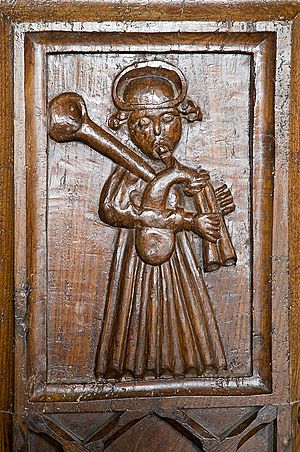Cornish bagpipes facts for kids
Cornish bagpipes (called Pibow sagh kernewek in the Cornish language) are a special type of bagpipes. They were once very popular in Cornwall, especially in the 19th century. People have found mentions of bagpipes and other pipes in old Cornish writings from as far back as the 1150s, all the way to the 1830s. We can also see pictures of bagpipes in Cornish art from the 1400s and 1500s.
Contents
Old Pictures of Bagpipes
You can find old pictures of bagpipes with two pipes (called "chanters") in churches across Cornwall. Some of these churches include Altarnun, Davidstow, St Austell, and Braddock, Cornwall. You can also see them in places like Marwood and Tavistock, Devon. A church in Launceston, Cornwall (built around 1520-1540) even has a picture of a bagpipe with just one chanter, along with other musical instruments.
It's important to look at these old pictures carefully. The oldest one, a carving at St. Austell from the 1400s, might just be a common decoration. The one at Davidstow, from the mid-1500s, might also be a general image, perhaps of an angel. There's even a picture of a dog playing bagpipes at Braddock, which was a common funny image back then.
However, some pictures, like those at Altarnun and Launceston, show people wearing clothes that look very real for the time (around 1520-1540). This suggests these images might show real local musicians and how they played bagpipes in Cornwall. The bagpiper at Tavistock looks similar, but the carving isn't detailed enough to be sure.
Bagpipes with Two Pipes
Pictures of bagpipes with two chanters were common about 600 years ago. You can find many such images not only in Cornwall but also in places like Yorkshire and Dorset. It's possible that because Cornwall was a bit isolated, these instruments stayed popular there longer than in other parts of England.
The bagpipe shown in the Launceston carving has a chanter that gets wider at the end (a "conical bore"). This kind of chanter would make a loud, full sound, which was great for playing music outdoors. The bagpipe at Altarnun has two chanters that are the same width all the way down (called "parallel bore"). These would make a quieter, reedy sound, better for playing inside. The two chanters at Altarnun are different lengths, which would make them play notes about one tone apart.
Modern Cornish Bagpipes
Since the late 1900s, people have started making new versions of these two-chanter bagpipes. These modern Cornish bagpipes can create interesting harmonies because of their two pipes. One pipe can play the higher notes, and the other can play the lower notes. Both pipes can even play the same main note, which allows a player to create a constant humming sound, called a drone, while playing the main tune. This drone effect is a very cool feature of these bagpipes. They are also great for playing deep, rich background music.
From the 1990s, instrument makers like Julian Goodacre have built many Cornish double-pipes. While not as many people play Cornish bagpipes as Scottish or Northumbrian ones, their popularity is growing. Merv Davey from Pyba has worked hard to explore what these instruments can do. Today, Cornish bagpipes are played at the Cornish Gorsedh, which is an important cultural festival. They have replaced the brass bands that used to play there in the early 1900s.
Why We Know About Them
Historians have studied old writings and pictures to learn about Cornish bagpipes. Early discussions wondered if bagpipes were truly common in Cornwall or if the word "pipes" just meant any kind of pipe, not necessarily bagpipes. However, later research looked closely at the details in the old pictures, especially the clothing. This suggests that the images at Altarnun and Launceston show real local musicians from the early 1500s playing bagpipes in Cornwall.
Summary of Cornish Bagpipes
Many old documents show that playing pipes was a big part of music in Cornwall during the Middle Ages. While some old pictures might just be general images, the detailed clothing in carvings at Altarnun and Launceston suggests they show real Cornish musicians from the early 1500s. These musicians played both bagpipes with one pipe and bagpipes with two pipes.
Bagpipes with two pipes were not only found in Cornwall, but they might have stayed popular there longer than in places like Dorset or Yorkshire. This could be because Cornwall was a bit isolated, or perhaps people there just really liked them. Even though there's a lot of proof for bagpipes in older times, fewer reports from later periods suggest that Cornish bagpiping became less common. However, in the late 1900s, people became interested again in the history of bagpiping in Cornwall. This led to new versions of the old pipes being built and people exploring how to play them and what music they could make.


